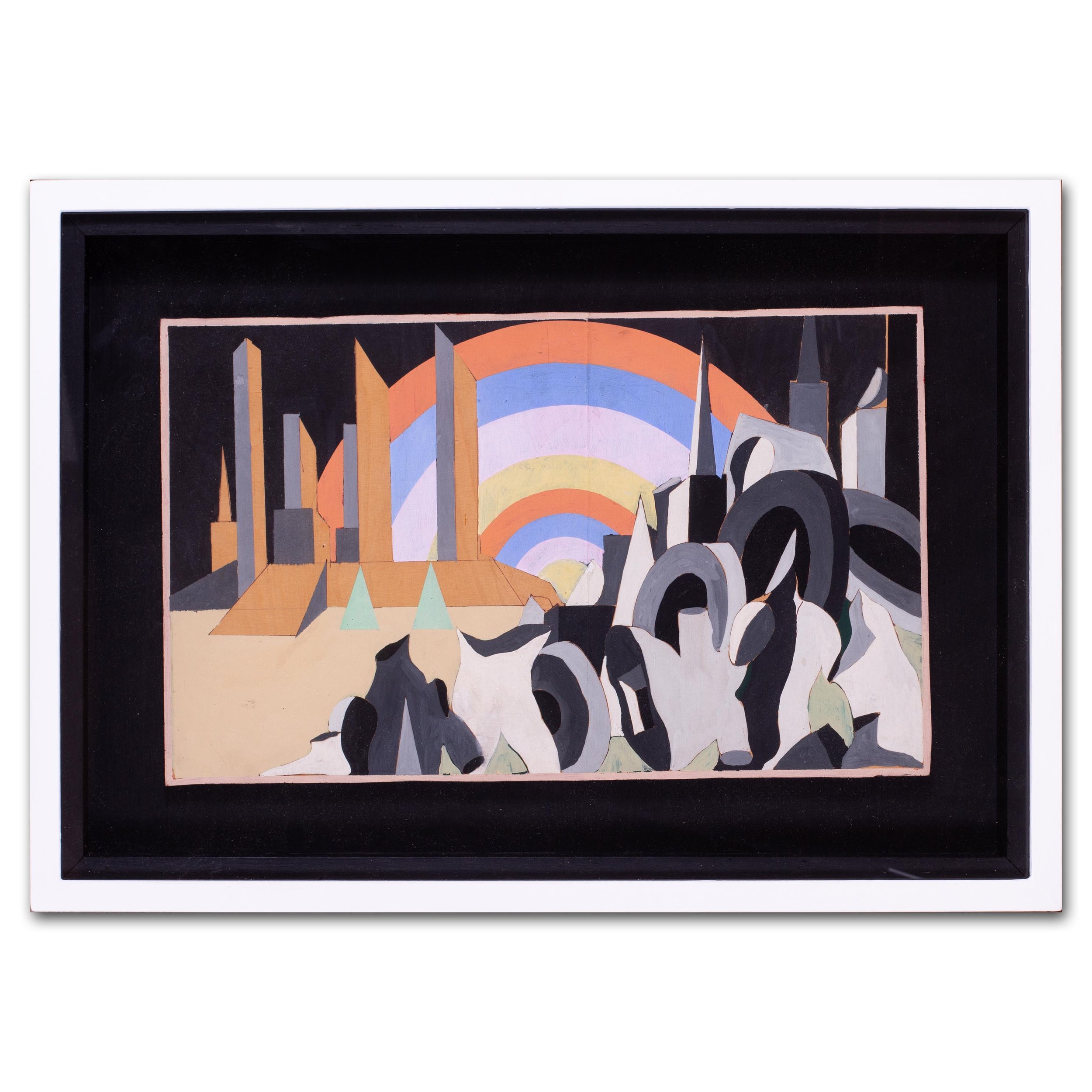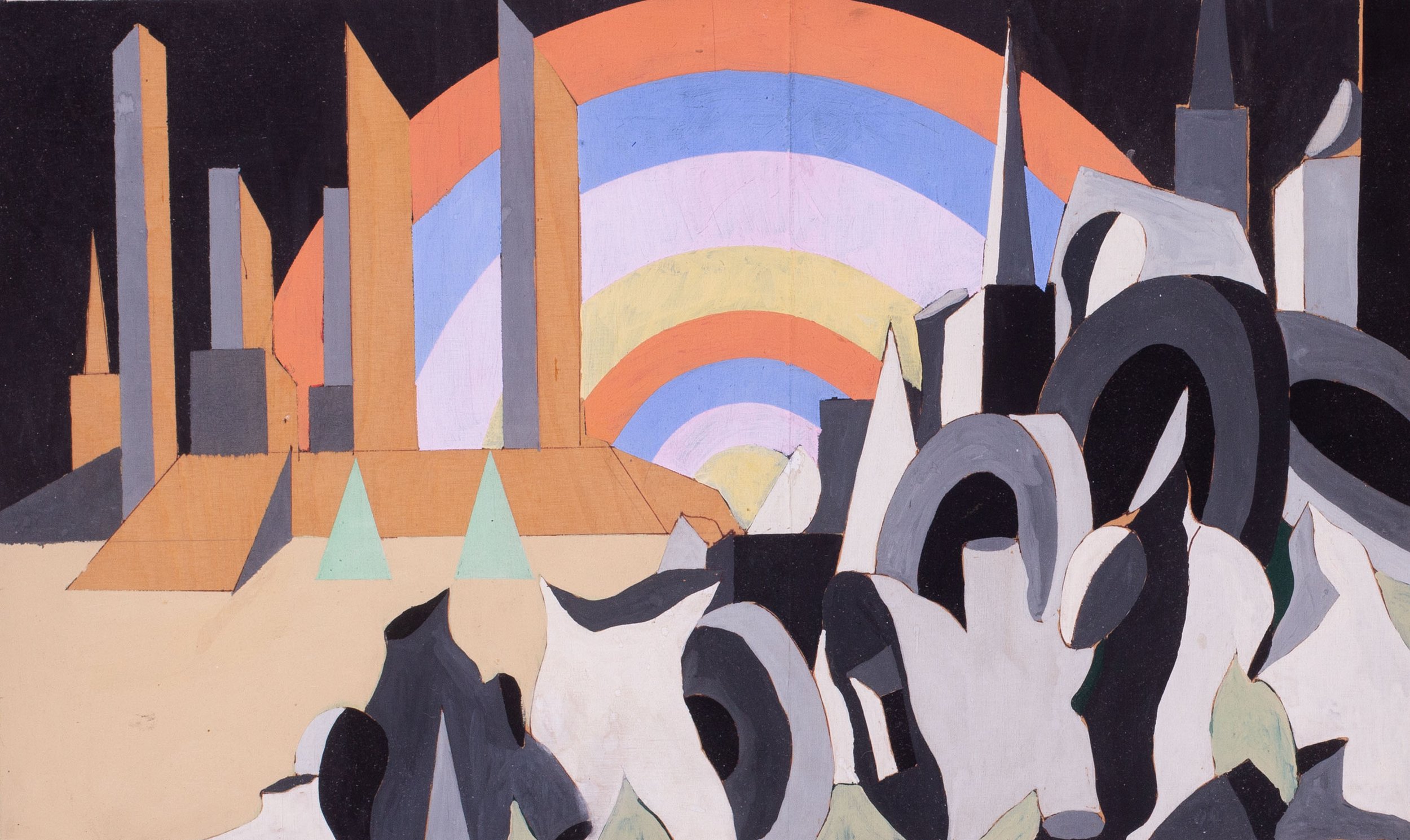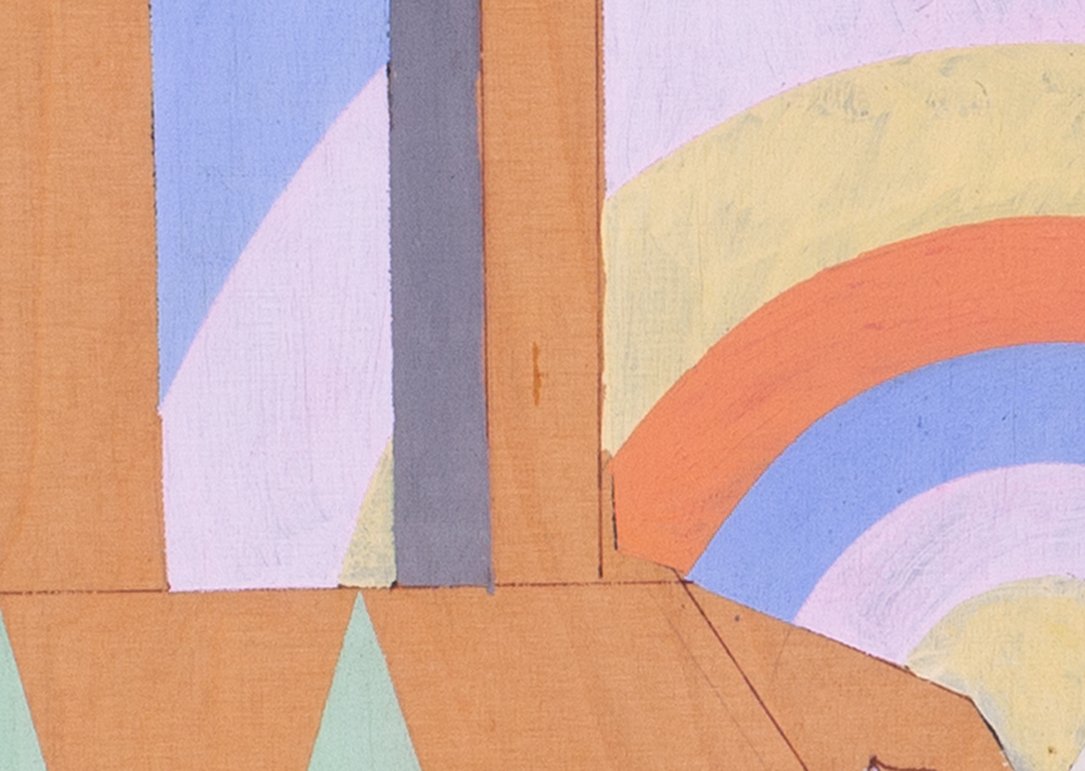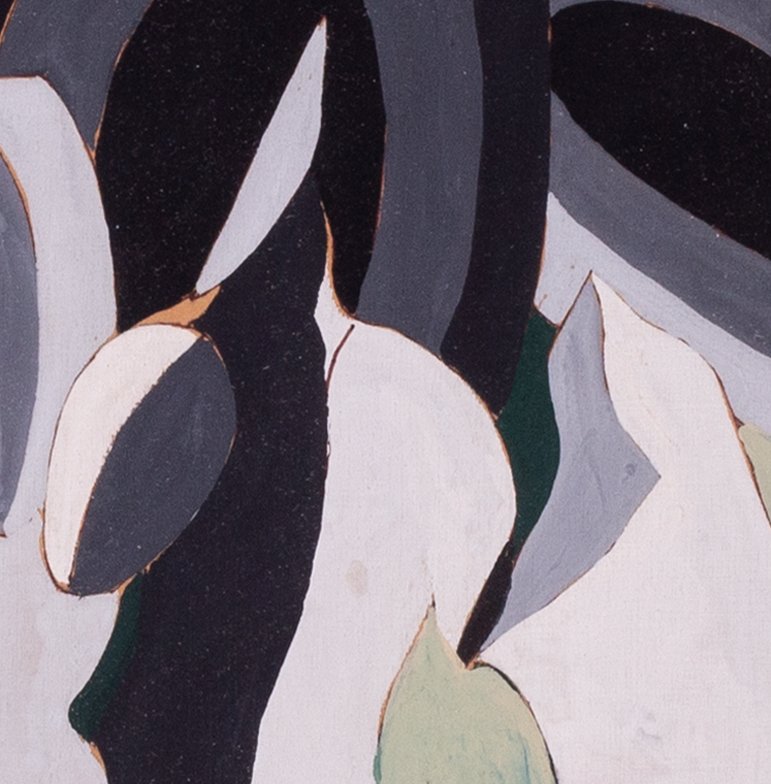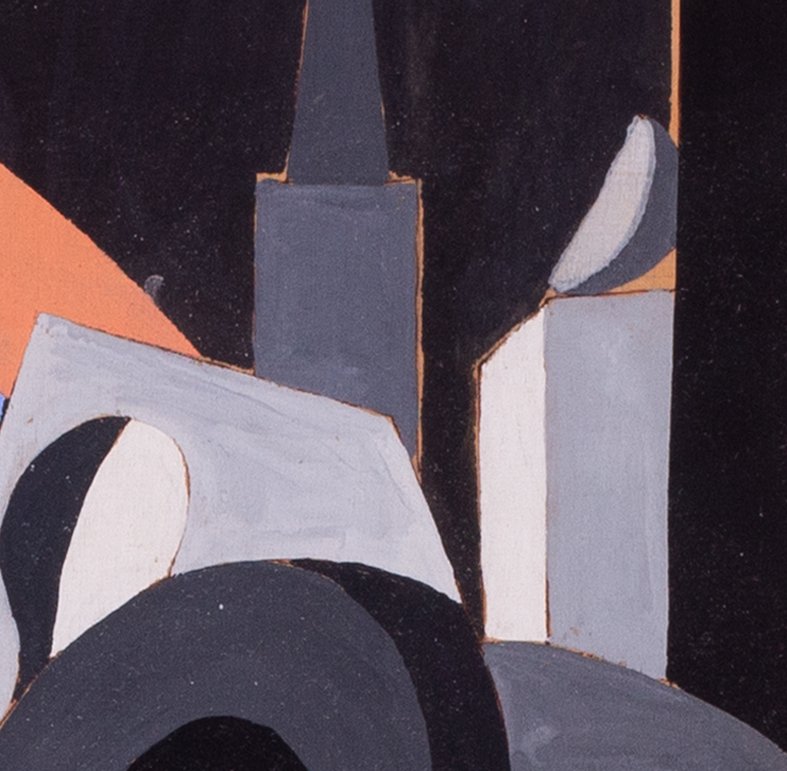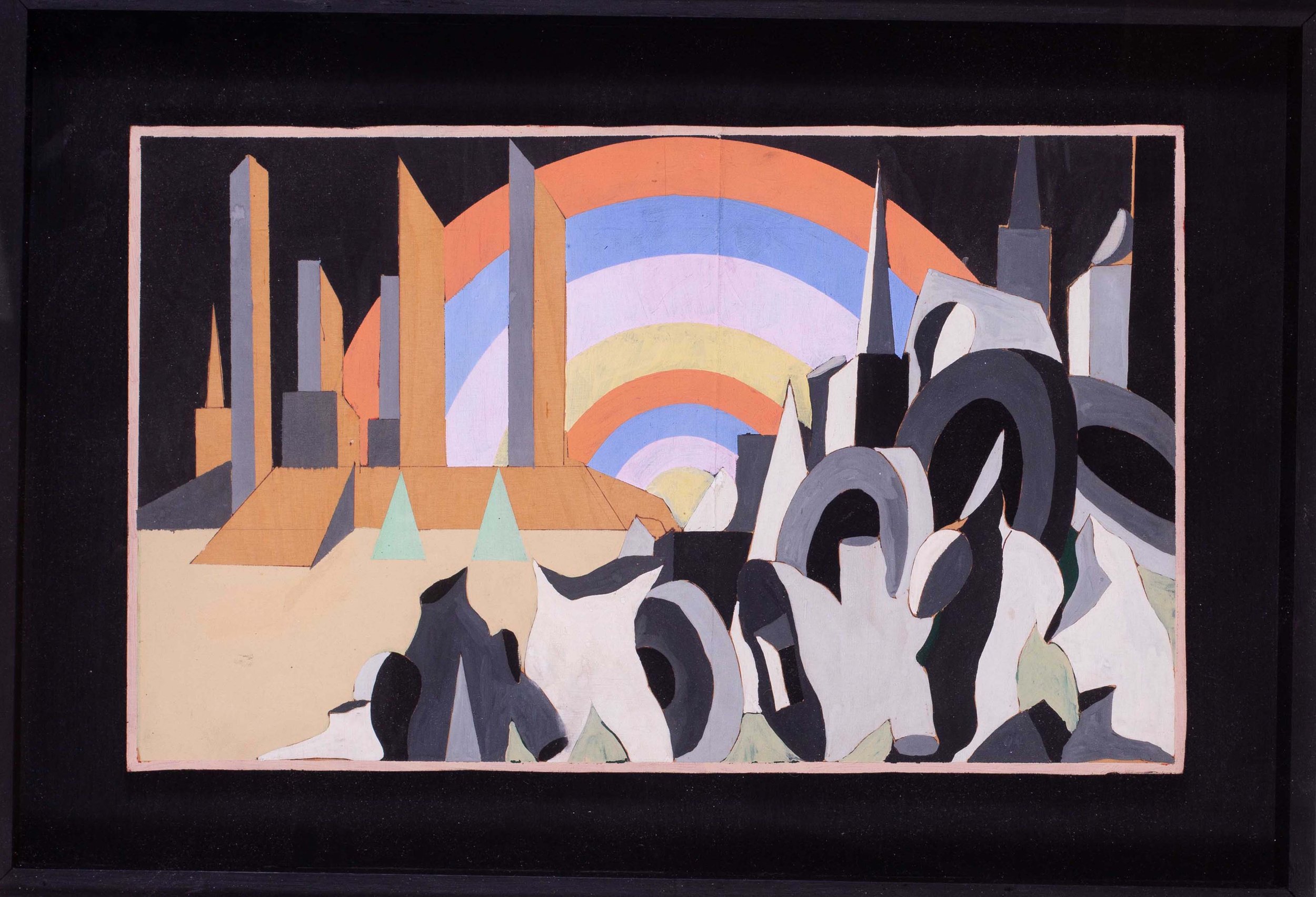Derek Jarman, 'Design for Don Giovanni Act 2, at the Sadler’s Wells Opera', 1968
Derek Jarman (British, 1942 – 1944)
Design for Don Giovanni Act 2, at the Sadler’s Wells Opera, 1968
Tempera on board
12 x 20.1/8 in. (30.5 x 51 cm.)
Provenance: On the reverse there is a photograph detailing the back of the picture which is now obscured as it is float mounted which is annoted as follows: ‘New cloth for act 1 and act 2 Don Giovanni Act 2 preliminary transitional cloth for the street / graveyard May 68’ (in the hand of the artist). It is accompanied by various articles and comparisons of other works
Derek Jarman participated in the first Lisson exhibition, a group show including artists Terence Ibbott, Paul Martin, Keith Milow and Paul Riley, after helping Nicholas Logsdail renovate three floors of derelict space on Bell Street in 1967.
Simon Field reviewed his first solo show in 1969 in Art & Artists, writing: "Derek Jarman’s paintings at the Lisson Gallery have the atmosphere of Surrealism although it is difficult to pin down why. His landscapes are in no traditional sense surreal, as those of Tanguy or Dalí, they are more reminiscent of surveys, outlines of an imaginary landscape. The canvases are, with one exception, a uniform, flat green. Several thin lines pass horizontally across creating the contours, at random, like Duchamp’s Three Standard Stoppages. Verticals create a perspective, acting against the flatness. Another dimension is added with pieces of flat marble-patterned material, as in Landscape with Marble Mountain. The strange quality of the paintings comes from their landscape feeling without any traditional three-dimensionality; they have a strong two-dimensional feel in spite of perspective devices, some of which act in contradiction to each other.
Any three-dimensionality occurs out from the canvas – through the introduction of the pieces of marble material. Jarman is also developing this aspect of his work in theatrical constructions, encouraged by his recent designs for Don Giovanni and the influence of Schlemmer at the Bauhaus. The structural elements in the paintings emerge into the third dimension, thin steel frames, cubes, triangles are now surrounded by real space. The artist’s profound sense of theatre often comes through in his paintings, particularly Landscape with Sculpture Garden. The objects, triangles in marble, sculptured arches, stagey trees, suggest three dimensionality, but at the same time deny it, like backdrops, reacting to the overall flatness of the canvas. For me, his work remains most powerful within the ambiguities of two dimensions."
Derek Jarman (British, 1942 – 1944)
Design for Don Giovanni Act 2, at the Sadler’s Wells Opera, 1968
Tempera on board
12 x 20.1/8 in. (30.5 x 51 cm.)
Provenance: On the reverse there is a photograph detailing the back of the picture which is now obscured as it is float mounted which is annoted as follows: ‘New cloth for act 1 and act 2 Don Giovanni Act 2 preliminary transitional cloth for the street / graveyard May 68’ (in the hand of the artist). It is accompanied by various articles and comparisons of other works
Derek Jarman participated in the first Lisson exhibition, a group show including artists Terence Ibbott, Paul Martin, Keith Milow and Paul Riley, after helping Nicholas Logsdail renovate three floors of derelict space on Bell Street in 1967.
Simon Field reviewed his first solo show in 1969 in Art & Artists, writing: "Derek Jarman’s paintings at the Lisson Gallery have the atmosphere of Surrealism although it is difficult to pin down why. His landscapes are in no traditional sense surreal, as those of Tanguy or Dalí, they are more reminiscent of surveys, outlines of an imaginary landscape. The canvases are, with one exception, a uniform, flat green. Several thin lines pass horizontally across creating the contours, at random, like Duchamp’s Three Standard Stoppages. Verticals create a perspective, acting against the flatness. Another dimension is added with pieces of flat marble-patterned material, as in Landscape with Marble Mountain. The strange quality of the paintings comes from their landscape feeling without any traditional three-dimensionality; they have a strong two-dimensional feel in spite of perspective devices, some of which act in contradiction to each other.
Any three-dimensionality occurs out from the canvas – through the introduction of the pieces of marble material. Jarman is also developing this aspect of his work in theatrical constructions, encouraged by his recent designs for Don Giovanni and the influence of Schlemmer at the Bauhaus. The structural elements in the paintings emerge into the third dimension, thin steel frames, cubes, triangles are now surrounded by real space. The artist’s profound sense of theatre often comes through in his paintings, particularly Landscape with Sculpture Garden. The objects, triangles in marble, sculptured arches, stagey trees, suggest three dimensionality, but at the same time deny it, like backdrops, reacting to the overall flatness of the canvas. For me, his work remains most powerful within the ambiguities of two dimensions."
Derek Jarman (British, 1942 – 1944)
Design for Don Giovanni Act 2, at the Sadler’s Wells Opera, 1968
Tempera on board
12 x 20.1/8 in. (30.5 x 51 cm.)
Provenance: On the reverse there is a photograph detailing the back of the picture which is now obscured as it is float mounted which is annoted as follows: ‘New cloth for act 1 and act 2 Don Giovanni Act 2 preliminary transitional cloth for the street / graveyard May 68’ (in the hand of the artist). It is accompanied by various articles and comparisons of other works
Derek Jarman participated in the first Lisson exhibition, a group show including artists Terence Ibbott, Paul Martin, Keith Milow and Paul Riley, after helping Nicholas Logsdail renovate three floors of derelict space on Bell Street in 1967.
Simon Field reviewed his first solo show in 1969 in Art & Artists, writing: "Derek Jarman’s paintings at the Lisson Gallery have the atmosphere of Surrealism although it is difficult to pin down why. His landscapes are in no traditional sense surreal, as those of Tanguy or Dalí, they are more reminiscent of surveys, outlines of an imaginary landscape. The canvases are, with one exception, a uniform, flat green. Several thin lines pass horizontally across creating the contours, at random, like Duchamp’s Three Standard Stoppages. Verticals create a perspective, acting against the flatness. Another dimension is added with pieces of flat marble-patterned material, as in Landscape with Marble Mountain. The strange quality of the paintings comes from their landscape feeling without any traditional three-dimensionality; they have a strong two-dimensional feel in spite of perspective devices, some of which act in contradiction to each other.
Any three-dimensionality occurs out from the canvas – through the introduction of the pieces of marble material. Jarman is also developing this aspect of his work in theatrical constructions, encouraged by his recent designs for Don Giovanni and the influence of Schlemmer at the Bauhaus. The structural elements in the paintings emerge into the third dimension, thin steel frames, cubes, triangles are now surrounded by real space. The artist’s profound sense of theatre often comes through in his paintings, particularly Landscape with Sculpture Garden. The objects, triangles in marble, sculptured arches, stagey trees, suggest three dimensionality, but at the same time deny it, like backdrops, reacting to the overall flatness of the canvas. For me, his work remains most powerful within the ambiguities of two dimensions."

